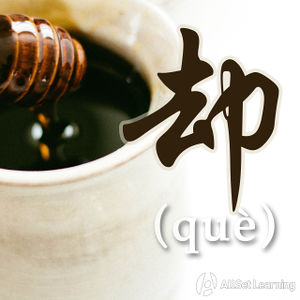Difference between revisions of "The "however" adverb "que""
| Line 15: | Line 15: | ||
<li class="x">我 等 了 她 很 长 时间 ,<strong>却</strong> 她 没 来 。 </li> | <li class="x">我 等 了 她 很 长 时间 ,<strong>却</strong> 她 没 来 。 </li> | ||
<li class="o">我 等 了 她 很 长 时间 ,她 <strong>却</strong> 没 来 。 </li> | <li class="o">我 等 了 她 很 长 时间 ,她 <strong>却</strong> 没 来 。 </li> | ||
| − | <li class="x">有 | + | <li class="x">有 些 人 的 博客 的 文章 不 多 , <strong>却</strong> 内容 不 错 。</li> |
| − | <li class="o">有 | + | <li class="o">有 些 人 的 博客 的 文章 不 多 , 但是 内容 <strong>却</strong> 不 错 。</li> |
| − | <li class="o">有 | + | <li class="o">有 些 人 的 博客 的 文章 不 多 , 但是 内容 不 错 。</li> |
</ul> | </ul> | ||
Revision as of 03:00, 3 July 2012
却 (què) is used to indicate something was contrary to expectations, and is used in a similar way to 倒. However, it is generally followed by a negative comment:
Structure
A + positive comment, B + 却 + negative comment
It's also important to point out that 却 is not a conjunction; it's an adverb. Practically speaking, this means that rather than joining two statements, it goes inside a statement. Specifically, it needs to come after the subject and before the verb. (Note that when you use a conjunction like 但是 it comes before the subject! 却 is different in this respect. Also, rather than replacing 但是, it can work with it to add emphasis.
- 我 等 了 她 很 长 时间 ,却 她 没 来 。
- 我 等 了 她 很 长 时间 ,她 却 没 来 。
- 有 些 人 的 博客 的 文章 不 多 , 却 内容 不 错 。
- 有 些 人 的 博客 的 文章 不 多 , 但是 内容 却 不 错 。
- 有 些 人 的 博客 的 文章 不 多 , 但是 内容 不 错 。
Examples
In the following examples, take note that 反而 comes after the subject in each case, and that it can be used together with 但是.
- 他 用 的 潜水 装备 都 很 专业,但是 他 的 水平 却 很 低。
- 虽然 是 自己 种 的 菜,不过 味道 却 没有 超市 的 好。
- 他 只有 16 岁,想法 却 比 20 几 岁 的 人 还 成熟。



